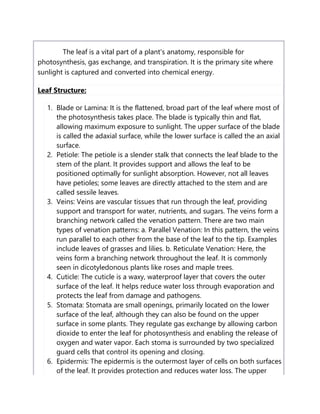
leaf structure.docx
- 1. The leaf is a vital part of a plant's anatomy, responsible for photosynthesis, gas exchange, and transpiration. It is the primary site where sunlight is captured and converted into chemical energy. Leaf Structure: 1. Blade or Lamina: It is the flattened, broad part of the leaf where most of the photosynthesis takes place. The blade is typically thin and flat, allowing maximum exposure to sunlight. The upper surface of the blade is called the adaxial surface, while the lower surface is called the an axial surface. 2. Petiole: The petiole is a slender stalk that connects the leaf blade to the stem of the plant. It provides support and allows the leaf to be positioned optimally for sunlight absorption. However, not all leaves have petioles; some leaves are directly attached to the stem and are called sessile leaves. 3. Veins: Veins are vascular tissues that run through the leaf, providing support and transport for water, nutrients, and sugars. The veins form a branching network called the venation pattern. There are two main types of venation patterns: a. Parallel Venation: In this pattern, the veins run parallel to each other from the base of the leaf to the tip. Examples include leaves of grasses and lilies. b. Reticulate Venation: Here, the veins form a branching network throughout the leaf. It is commonly seen in dicotyledonous plants like roses and maple trees. 4. Cuticle: The cuticle is a waxy, waterproof layer that covers the outer surface of the leaf. It helps reduce water loss through evaporation and protects the leaf from damage and pathogens. 5. Stomata: Stomata are small openings, primarily located on the lower surface of the leaf, although they can also be found on the upper surface in some plants. They regulate gas exchange by allowing carbon dioxide to enter the leaf for photosynthesis and enabling the release of oxygen and water vapor. Each stoma is surrounded by two specialized guard cells that control its opening and closing. 6. Epidermis: The epidermis is the outermost layer of cells on both surfaces of the leaf. It provides protection and reduces water loss. The upper
- 2. epidermis is usually transparent to allow light penetration, while the lower epidermis contains more stomata. 7. Mesophyll: The mesophyll is the inner tissue of the leaf, sandwiched between the upper and lower epidermis. It consists of two layers: a. Palisade Mesophyll: Located just below the upper epidermis, this layer contains tightly packed, elongated cells that are rich in chloroplasts. It is the main site of photosynthesis. b. Spongy Mesophyll: Below the palisade mesophyll, this layer contains loosely arranged cells with air spaces between them. The spongy mesophyll allows for gas exchange and facilitates the movement of gases within the leaf.
- 3. These various leaf structures work together to maximize the efficiency of photosynthesis, facilitate gas exchange, and minimize water loss in plants